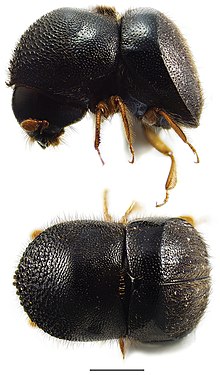| Cnestus mutilatus | |
|---|---|

| |
| Cnestus mutilatus | |
| Scientific classification | |
| Domain: | Eukaryota |
| Kingdom: | Animalia |
| Phylum: | Arthropoda |
| Class: | Insecta |
| Order: | Coleoptera |
| Suborder: | Polyphaga |
| Infraorder: | Cucujiformia |
| Family: | Curculionidae |
| Genus: | Cnestus |
| Species: | C. mutilatus |
| Binomial name | |
| Cnestus mutilatus (Blandford, 1894) | |
| Synonyms | |
| |
Cnestus mutilatus, commonly known as the camphor shot borer, camphor shoot borer, or sweetgum ambrosia beetle, is a species of ambrosia beetle in the subfamily Scolytinae of the weevil family Curculionidae. It is native to Asia, but has been established as an invasive species in the United States since 1999.
Description
Cnestus mutilatus adult females are mainly black in color, and are large and robust compared to most ambrosia beetles, ranging from 3.4 to 3.9 mm in length, and about 1.7 times longer than wide. This makes C. mutilatus the largest ambrosia beetle species found in North America. Their body shape is also distinctive compared to most ambrosia beetles, with an abdomen that is shorter than the head and thorax, and a sharp slope to the posterior end that gives them a severed or "squished" appearance. Adult male beetles are smaller, and flightless.
Distribution
Cnestus mutilatus is native to Asia, where it is known from Burma, China, India, Indonesia, Japan, Korea, Malaysia, New Guinea, Sri Lanka, and Thailand. In 1999, it was collected in traps in Mississippi (USA), and subsequent survey work found it to be widely established there. It has since spread throughout much of the eastern United States, from Florida north to Pennsylvania, and west to Illinois and Texas.
Ecology and behavior
Like other ambrosia beetles, Cnestus mutilatus carries a symbiotic species of fungus that it introduces into the host plant, and which serves as the primary food source for the adult beetles and larvae; the ambrosia fungus associated with C. mutilatus is Ambrosiella beaveri.
The female beetle tunnels directly through the bark and into the wood of the host tree's branches, attacking stems that are relatively small (typically 1 to 5 cm in diameter), and entering through circular holes that are about 2 mm in diameter. Their galleries (tunnels) typically extend horizontally into the stem for a short distance, before branching into long (up to 3.8 cm) vertical tunnels.
Damage to fuel containers
Cnestus mutilatus has been documented as damaging vessels and lines containing gasoline fuel, such as plastic fuel storage containers, lawnmower components, and boat fuel lines. They tunnel in through the plastic, creating small (~2 mm), circular entrance holes. This "accidental" damage (which often results in the death of the beetle) is apparently due to the fact that standard gasoline fuel in the United States contains up to 10% ethanol, which is a primary attractant of C. mutilatus, as a chemical released by stressed host trees.
References
- ^ Atkinson, Thomas H. "Cnestus mutilatus (Blandford 1894) (introduced)". Bark and Ambrosia Beetles. Retrieved 10 November 2019.
- ^ Oliver, Jason; Youssef, Nadeer; Hale, Frank; Klingeman, William; Halcomb, Mark; Haun, Walker. "Camphor Shot Borer: A New Nursery and Landscape Pest in Tennessee" (PDF). Tennessee State University. Retrieved 12 November 2019.
- ^ "Species Cnestus mutilatus - Camphor Shoot Borer". BugGuide. Iowa State University. Retrieved 10 November 2019.
- ^ Schiefer, Terence L. (2004). "Xylosandrus mutilatus (Blandford), an exotic ambrosia beetle (Coleoptera: Culrculionidae: Scolytinae: Xyleborini) new to North America". The Coleopterists Bulletin. 58 (3): 431–438. doi:10.1649/760. S2CID 84579273.
- ^ Skvarla, Michael J. "Camphor Shoot Borer (Cnestus mutilatus)". PennState Extension. Retrieved 12 November 2019.
- Six, Diana L.; Stone, W. Doug; de Beer, Z. Wilhelm; Woolfolk, Sandra W. (2009). "Ambrosiella beaveri, sp. nov., associated with an exotic ambrosia beetle, Xylosandrus mutilatus (Coleoptera: Curculionidae, Scolytinae), in Mississippi, USA". Antonie van Leeuwenhoek. 96 (1): 17–29. CiteSeerX 10.1.1.705.8626. doi:10.1007/s10482-009-9331-x. PMID 19319658. S2CID 1485785.
- ^ Carlton, Chris; Bayless, Victoria (2011). "A case of Cnestus mutilatus (Blandford) (Curculionidae: Scolytinae: Xyleborini) females damaging plastic fuel storage containers in Louisiana, U.S.A.". The Coleopterists Bulletin. 65 (3): 290–291. doi:10.1649/072.065.0308. S2CID 83542329.
- Swirko, Cindy (22 June 2018). "Misguided beetle causes woe for boats, mowers". The Gainesville Sun. Retrieved 12 November 2019.
| Taxon identifiers | |
|---|---|
| Cnestus mutilatus | |
This Scolytinae-related article is a stub. You can help Misplaced Pages by expanding it. |